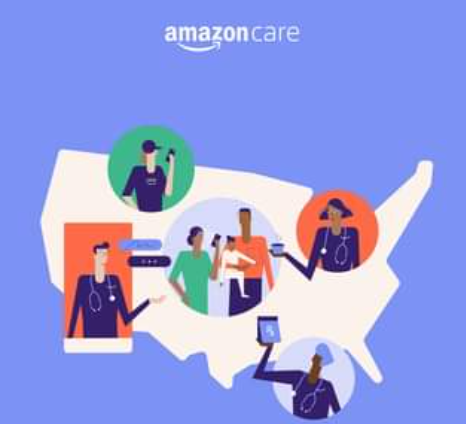The New England Journal of Medicine (NEJM)
Elizabeth Rourke, M.D.
December 18, 2021
businessinsider
I am scrolling through news on my phone while waiting in my car, parked on a city street near not one but two large Amazon vans, when I read that Amazon is entering my field, primary care.
While I watch the guys stacking up boxes bearing the ubiquitous smile logo, I wonder: Should I be freaked out about this?
As someone who likes to hang out in bookstores, I remember when there used to be a lot more of them, before Amazon undercut them to dominate the market. Will it do to clinical medicine what it did to brick-and-mortar retail?
Amazon comes to primary care at a challenging time for existing primary care providers. Despite primary care’s value in improving outcomes and reducing costs, in the United States, the field is beleaguered by comparatively low reimbursement and a resulting shortage of clinicians. The Covid pandemic further battered many practices by reducing revenues when offices closed for prolonged periods.
The expense of maintaining an unused office made doctors financially vulnerable, and it makes some sense that Amazon would target clinical care, given the resemblance between a doctor’s office and a brick-and-mortar store. We hire people, such as receptionists and medical assistants, to interact with patients, and not much of this work is done by robots. We pay rent on expensive real estate so we have somewhere to practice. Our hours are limited by our human lives, by our desire to go home and have dinner with our families and sleep overnight. These requirements result in both costs and potential inconvenience for patients, creating an opening for more technologically mediated services such as telemedicine-based providers.
Amazon’s interest in clinical care, however, substantially predates the pandemic. Longtime Amazon watcher Brad Stone reports that the company has been targeting the multitrillion-dollar U.S. health care market for years, striving always for continued growth.
Stone writes that Amazon founder Jeff Bezos “believed there was significant potential for disruption and innovation in healthcare and met regularly with a secretive group inside the company, dubbed the ‘grand challenge,’ whose purpose was to generate and pursue ideas in the field.”1
By July 2021, these efforts had resulted in an “all-out push to reinvent just about every aspect of health care, from how patients get primary care to how large hospitals diagnose and treat diseases.”2
Amazon Care, the company’s virtual-first clinical care offering, is one outcome of this work. The service is a combination of telemedicine and in-home care, comprising three components: a smartphone-based app that uses a chatbot and then allows text or video interaction with a nurse and, if desired, a doctor; home-based diagnostic assessment, if necessary, performed by a nurse; and delivery of prescriptions within 2 hours if patients choose to use Amazon’s pharmacy, which came online in November 2020.
Amazon Care is a “hybrid virtual and in-person experience” in which providers who “might need a little bit more information can dispatch a nurse to the home, and if necessary the nurse can call back in order to make the diagnosis,” Sunita Mishra, medical director of Amazon Care, explains. Kristen Helton, director of Amazon Care, notes that employing a nurse, rather than a doctor, for the in-home component was a cost-effective choice but also “a data-driven approach” — the company considered all visit types and calculated that it “could cover a significant percentage of care with a virtual provider coupled with an in-person nurse.”
Amazon Care began by addressing urgent care–type medical issues, and just recently added primary care in response to patient demand, according to Mishra. In addition to urgent care and primary care, the service is seeking other areas of care to address. “Our in-home service is a tipping-point,” Mishra told me. “It does allow us to do more care. In time we believe that it will replace other types of care.”

When patients’ needs exceed Amazon’s capabilities, care coordinators refer them to outside providers who accept their insurance. Amazon Care follows up on referrals through “multiple channels” to “close that loop,” according to Mishra. The goal, Helton says, is to “prevent higher-cost use, keeping patients out of urgent cares and ERs.”
Amazon began by offering the service to some employees at its Seattle headquarters in September 2019, just months before the Covid pandemic caused intensified interest in remote care. Despite Amazon’s long-standing strength in customer relations, the service is being marketed not to individuals but to companies, as a benefit employers can offer on top of conventional health insurance.
In adopting this structure, developed by telemedicine pioneer Teladoc, Amazon Care joins an expanding field of commercial health care offerings, which includes both telemedicine providers and “direct” primary care companies (so named because they generally bypass insurance). Since the Covid pandemic began, investment interest in direct-to-consumer telemedicine has exploded, and several companies in this field have begun offering “virtual-first” primary care. In addition, direct primary care — which typically involves a hybrid of telemedicine and brick-and-mortar clinics — has grown, fueled in part by venture capital. Amazon also joins other large retailers, such as Target and Walmart, that have long hosted retail clinics in their stores. Walmart, the only U.S. company larger than Amazon, has expanded from company-owned urgent care clinics to open 20 more comprehensive “Walmart Health” clinics offering primary care and other services, in addition to purchasing telemedicine provider MeMD.
In March 2021, Amazon started marketing Amazon Care to U.S. employers beyond Amazon and commenced efforts to hire staff in “all major U.S. cities,” according to its website. In October 2021, Helton announced that Amazon Care will roll out in-person services in Los Angeles, Dallas, Chicago, Philadelphia, and Boston before the end of 2021, in addition to its established services in Washington State and the Baltimore–Washington, D.C., area. Business news service Insider reports that Amazon plans to add 16 more cities in 2022.
Because Amazon Care has been in place in Seattle the longest, I contacted the president of the Washington State Medical Association, Nathan Schlicher, to find out how it has affected the state’s health care market. Schlicher hadn’t yet seen any significant impact, but he noted that Amazon Care’s lack of insurance billing means that it, like other telemedicine and direct offerings, exists “in the consumer space,” which is less heavily regulated. “Just because you’re not regulated doesn’t mean that quality doesn’t apply,” Schlicher notes.
At least some people who think about the future of medicine for a living don’t seem alarmed about Amazon’s arrival in the clinical “space.” James Merlino, chief clinical transformation officer at the Cleveland Clinic, told me that competition from Amazon and other direct-to-consumer telemedicine providers “will make us better.” Merlino believes that Amazon’s presence in the marketplace “requires us to look differently at how we do things” and innovate in response.
Similarly, Kaiser Permanente’s executive vice president for health plan operations, Arthur Southam, said he wasn’t surprised by the rollout of Amazon Care. Surveying the crowded field of direct-to-consumer telemedicine, Southam argues that “Amazon’s entry into the space is newsworthy because of the sophistication of Amazon, but this is not a novel offering.”
Despite these reassurances, my unease persists. Although Amazon Care provides convenience, its primary care offering necessarily lacks comprehensiveness, one of the four established “pillars” of primary care (along with first contact, continuity, and coordination). It can thus either provide care exclusively to healthy people with only minor problems, or it can exacerbate the fragmentation of sicker patients’ care. Insofar as Amazon Care is best suited to healthy people and is backed by Amazon’s wealth and market prowess, it also threatens to further fragment the health care market itself. I worry about the financial viability of already-stressed primary care practices if substantial numbers of young, healthy patients get their care from Amazon, leaving only the sickest and most difficult-to-treat patients behind.
Economics aside, there’s an atavistic level on which Amazon’s entry into primary care gives me pause. Amazon came to clinical care intending to reinvent the field with technology. I can’t help fearing that the company’s staggering wealth will give it the power to dictate how things will be. I’m not interested in living in a world that Amazon makes. Its priorities are not my priorities, and I’d rather not have Amazon telling me how primary care is going to work.
Amazon Care’s very existence is a symptom of the misaligned incentives and yawning gaps in U.S. health care.
It’s a long way from dropping goods on my doorstep to managing the complexity that even patients with the most straightforward needs bring to primary care.
It’s this realization that gives me hope — hope that the messiness of human lives can challenge any easy, limited solution.
Hope that human beings, at the end of the day, need human doctors.
Disclosure forms provided by the author are available at NEJM.org.
This article was published on December 18, 2021, at NEJM.org.
Author Affiliations
From Brigham and Women’s Hospital and Harvard Medical School — both in Boston.
References
See the original publication
Originally published at https://www.nejm.org.












